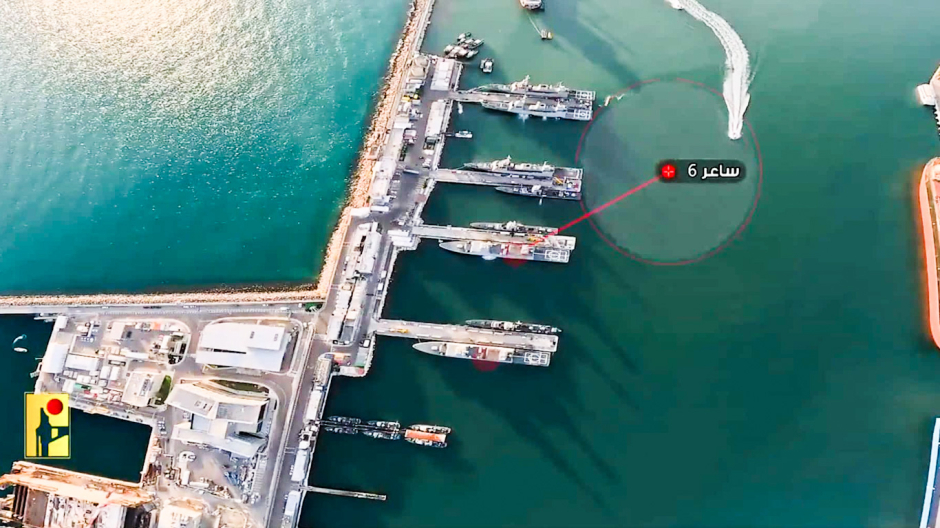all-out war" against Lebanon. Not only did this cause hysteria among Israelis living in Haifa, but it also triggered a series of Israeli media outlets and institutes to conduct analyses of various aspects of what was shown.
#بالفيديو |الإعلام الحربي في المقاومة الإسلامية ينشر مشاهد إستطلاع جوي لقواعد استخبارات ومقرات قيادية ومعسكرات في #الجولان العربي السوري المحتل عادت بها طائرات القوة الجوية في المقاومة الإسلامية. #الميادين #الهدهد pic.twitter.com/VImIZ2GYXP
- قناة الميادين (@AlMayadeenNews)
One such analysis was provided by the Alma Research and Education Center, run by Israeli Reserve Army Lieutenant Colonel Sarit Zehavi, which attempted to work out what kind of drone was used by Hezbollah and whether the footage was taken over the past weeks or months, failing to ascertain much at all. The lack of knowledge from Israeli organizations (with ties to its military and who brief U.S. politicians) was telling. What has not been disputed are Hezbollah's claims that the sites depicted included an "industrial site run by Rafael Advanced Defense Systems Ltd., Iron Dome platforms, missile warehouses, and missile component manufacturing sites."
Commenting on the release of the first Hudhud footage, the Secretary General of Lebanese Hezbollah, Seyyed Hassan Nasrallah, addressed the Israeli attempt to understand what they had all witnessed and stated that the footage was all taken from a single drone on one journey and that some two hours of total video were collected.
The nine-minute Hudhud part two video, despite featuring a region less sensitive to the average Israeli, is even more of a cause for concern to their military. While the illegally occupied Golan Heights represents a skiing holiday destination in the minds of regular Israelis, it is a pivotal region for military operations, intelligence gathering and defending against cross-border operations. In the new video, the drone traveled at least 46 kilometers deep into Israeli-held territory, mapping out "six strategic sites for electronic surveillance," in addition to various military sites that were set up in the aftermath of the October 7 Hamas-led assault on southern occupied Palestine.
The second episode covers the occupied Golan heights. t.co pic.twitter.com/L232gRKo34
- Ali Hashem علي هاشم (@alihashem_tv)
Hezbollah also revealed that this was not the first time it had conducted reconnaissance over these areas. Corroborating this claim is the fact that some of the sites shown in the video were previously targeted by the Lebanese armed group, including the Mount Hermon military base. In fact, on the same day that it published the new Hudhud drone footage, Hezbollah fired dozens of Katyusha rockets in response to an Israeli airstrike that assassinated a member of the group in Syria the day prior, killing two Israelis in the Golan Heights when their vehicle was struck.
During Seyyed Hassan Nasrallah's latest speech this Wednesday, he stated that "the enemy [Israel] is terrified, not only of the resistance entering the Galilee but of the mere idea of infiltration, prompting them to enhance their human presence to compensate for technological losses." Mocking the Israeli military and political leadership, Nasrallah said of their demands to move Hezbollah forces back from the border that "the enemy initially talked about pushing Hezbollah 3km away from the borders. We revealed our Kornet weapon with an 8km range, so the enemy wanted to push us 8km away. Then we revealed our al-Mass missile with a 10km range, and now the enemy wants to push us 10km away".
If Israel launches an offensive against Lebanon, it has been demonstrated that Hezbollah possesses not only the fighters and offensive capabilities to respond successfully but also the intelligence capabilities. Operation al-Aqsa Flood, led by Hamas on October 7, demonstrated an intimate knowledge, by the group's armed wing, of sensitive military sites belonging to the Israeli southern command and led to its temporary collapse that day. Hamas has nowhere near the capabilities of Hezbollah, which has demonstrated its ability to operate UAVs for reconnaissance purposes deep into Israeli-held territory without even being engaged by Israel's air defense systems.
Although the element of surprise may not be there in the event of Hezbollah attacks, the wealth of its knowledge and ability to hit targets it has acquired supersedes that of Hamas, which is a clear cause for concern to an Israeli military that has had many of its monitoring positions gutted by over 2,000 attacks by Hezbollah since October 8.
Feature photo " target="_blank">A screenshot from video released by Hezbollah and taken by a Hezbollah reconnaissance drone shows sensitive Israeli military sites.
Robert Inlakesh is a political analyst, journalist and documentary filmmaker based in London, UK. He has reported from and lived in the occupied Palestinian territories and hosts the show 'Palestine Files'. Director of 'Steal of the Century: Trump's Palestine-Israel Catastrophe.' Follow him on Twitter @falasteen47
